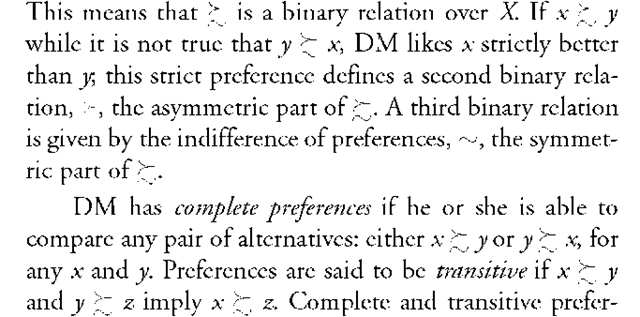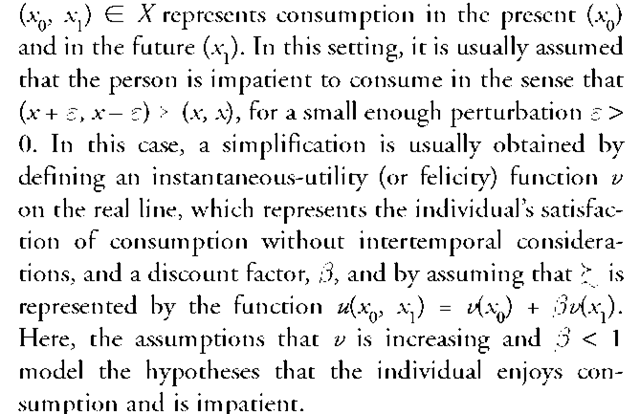Preferences are value judgments about the relative desirability of alternatives. In decision theory, the decisionmaker’s preferences are the criteria used to compare the alternatives available for choice. But preferences need not be related to choice: They may also represent how an entity values outcomes, or states of the world, that it does not choose. Depending on the setting, preferences may be objective or subjective.
In abstract, given a set X a menu of alternatives that may be chosen or that may simply occur, an entity’s preferences are a binary relation defined on X. Given two alternatives, x and y, this relation answers the question "Is x at least as good as y?" When, according to the entity, the answer is "yes," one says that the entity weakly prefers x to y (denoted x ^ y).
Historically, preferences were initially treated as cardinal objects: it was postulated that to any alternative x one could attach a number u(x), measuring the level of inner happiness, or utility, derived from it. Classical analyses in distributive justice and in economics during the eighteenth and nineteenth centuries, such as the utilitarianism of Jeremy Bentham (1748-1832) or the marginalism of William Stanley Jevons (1835-1882) and Carl Menger (1840-1921), required cardinal utilities. The independent contributions of Vilfredo Pareto (1848-1923) and Irving Fisher (1867-1947) in the late nineteenth century emphasized that only the ordinal information of preferences matters: That an entity prefers one alternative to another is merely a ranking. After the work of John Hicks (1904-1989) in the 1930s and Kenneth Arrow in the 1950s, it is commonly accepted that preferences are ordinal.
Suppose that a decision-maker (DM) is choosing from a menu X, and let x and y be two alternatives. It is clear that either DM likes x at least as much as y, likes y at least as much as x, is indifferent (both previous statements being true), or is unable to tell (neither statement is true).
ences constitute a complete preorder, which is the most basic assumption on tastes of a decision-maker: DM is then said to be rational.
In more specific settings, additional structure allows for further properties. When Xis a field over the real numbers (for example, a Euclidean space), preferences are convex if any average of alternatives is preferred to the least-preferred averaged alternative. When a definition of more exists for X, preferences are said to be monotonic if more implies better. When X is endowed with a topology, preferences are continuous if the at-least-as-good-as property is preserved under limits.
Preferences are representable if there exists a "utility" function, mapping X into the real line, with the property that x ^ y if, and only if, the value of the mapping at x is at least its value at y. In the 1950s Gerard Debreu (1921-2004) presented the seminal solution to the repre-sentability problem for continuous preferences. Representability does not mean that preferences have cardinal meaning: While any two functions representing given preferences contain, by construction, the same ordinal information, their cardinality may differ nontrivially. Given representable preferences, a property is ordinal if it is preserved upon increasing transformation of its representations, while cardinal properties are preserved only by affine, increasing transformations.
In economics, demand theory studies the individual choice of a bundle of commodities, at given prices and income, with preferences understood to be subjective and ordinal. In applications, a useful family of preferences delivers invariant substitution effects: The constant elasticity of substitution (CES) family includes linear preferences (perfect substitutability), Leontief preferences (perfect complementarity), and Cobb-Douglas preferences (unitary elasticity of substitution). Homothetic preferences deliver demand functions that are homogeneous of degree one in income, while, with some qualification, quasi-linear preferences isolate all commodities but one from income effects.
When X represents an intertemporal situation, some structure is usually imposed on preferences. Suppose that
When the individual faces risk, the outcome of his or her choice is a random variable. In this case, X is a set of random variables (lotteries), ^ ranks these variables ex-ante (in ignorance of the outcome that they will realize), and, in general, the standard analysis of preferences applies. As in the case of intertemporal preferences, a simplification is obtained via representation by utility functions. Leonard J. Savage (1917—1971) provided axioms that guarantee the existence of an expected utility representation, as defined by Daniel Bernoulli (1700-1782) in the eighteenth century: The ex-ante utility of a lottery is measured by the mathematical expectation of the well-being that the individual would derive from the outcome of the lottery were it not subject to risk, the induced random variable v(x). In this case, the felicity function has cardinal meaning: Only upon affine transformations is the representation of preferences preserved. Under expected utility, the curvature of function is used to measure individual dislike of risk. Arrow proposed two measures of risk aversion: absolute (the negative of the ratio of the second to the first derivatives of v) and relative (the absolute measure times the consumption level). An exponential representation of v exhibits constant absolute risk aversion, whereas an adaptation of the CES family yields constant relative risk aversion. Under uncertainty, completeness of preferences has been questioned: When unsure about the probabilities of different states of the world, individuals may be unable to compare all alternatives.
While research on choice often takes preferences as given, there are different theories about how humans form value judgments. In mathematical psychology, laboratory observation has led to the hypothesis that preferences (human and animal) are themselves random objects, which implies that choice itself is random (see, for example, the work of Duncan Luce and Patrick Suppes). Other prominent theories have considered the influence of experience and social interactions in the determination of preferences: While a basic view may take them as physiologically determined (so choice appears as a cognitive process), a broader view takes into account the influence of an individual’s history or social context on the determination of tastes, from which choice appears as a behavioral phenomenon. These theories account for the learning processes that are embedded in sequential decision problems, for the effects of habit formation (for example, addictions) or for the influence of fashion or peer pressure on behavior (see the work of Gary Becker). Also, Amos Tversky (1937-1996) and Daniel Kahneman observed that the way in which a decision problem is framed seems to affect the choices of many individuals, which highlights the effects of perception on preferences. One more apparent anomaly of the standard theory arises in intertemporal problems, as evidence shows that often individuals choose not to delay the realization of a negative effect, which is at odds with the usual impatience postulate.
The problem of explaining how groups of individuals value alternatives has led to the definition of social preferences. An important difficulty in this direction was presented by Arrow in the mid-1950s: Under certain axioms, it is impossible to aggregate individual preferences into social preferences without the imposition of a "dictator" whose preferences are assumed for the whole society. Competing theories of social justice—for example, utilitarianism, Rawlsianism, or Robert Nozick’s (1938-2002) libertarianism—provide prominent discussions of social preferences.


